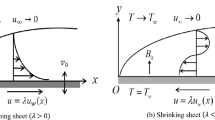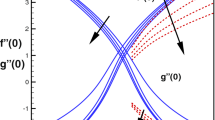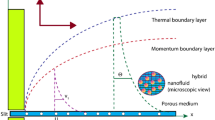Abstract
Investigation of nanofluids heat transport under hydrogen bonding is a key area of research because of their broad spectrum applications more specifically in applied thermal and chemical engineering, etc. Although, conventional fluids are good for heat transfer but sometimes these fail to produce considerable amount of heat to accomplish many engineering and industrial production processess. Therefore, new innovative classes called hybrid and ternary nanofluids introduced with enhanced heat transport characteristics. Due to increasing demand of new heat transport fluids, a study for transient heat transfer and entropy generation in Darcy Forchheimer Flow of ternary nanofluid is conducted between parallel plates. The desired model achieved by practicing the transformations parameters and characteristics values of nanofluids calculated using their enhanced thermophysical correlations. The core effects of slanted magnetic field, thermal radiations, CCHFM (Cattaneo Christov Heat Flux Model), heating source and Newtonian heating integrated in the model to make it more beneficial in broad physical context. Then, an efficient scheme GM (Galerkin Method) adopted to examine the model heat transport, irreversibility, skin friction and thermal gradient behaviour at various parametric stages. The porous medium and slanted magnetic field are advantageous to control the fluid movement in the channel ranging from 0.1 to 0.7. The addition of CCHFM, dissipation and internal heating effects playing dynamic role and enhanced the performance of ternary nanofluid. The irreversibility of the system can be enhanced by strengthening \(\alpha _{1} ,H_{{\text{a}}}\) and \({R}_{{\text{d}}}\) keeping in the range of 0.1 to 0.7. Also, addition of dissipation function boosts the irreversible process. Further, for skin friction and thermal gradient, the role of ternary nanofluid observed dominant compared to simple, nano and hybrid nanofluids.












Similar content being viewed by others
Data availability
The data that supports the findings of this study are available within the article.
References
Mukherjee S, Chakrabarty S, Mishra PC, Chaudhuri P. Transient heat transfer characteristics and process intensification with Al2O3-water and TiO2-water nanofluids: an experimental investigation. Chem Eng Process - Process Intensif. 2020. https://doi.org/10.1016/j.cep.2020.107887.
Deng S, Xiao T. Transient two-layer electroosmotic flow and heat transfer of power-law nanofluids in a microchannel. Micrimachines. 2022. https://doi.org/10.3390/mi13030405.
Khan MN, Ullah N, Nadeem S. Transient flow of maxwell nanofluid over a shrinking surface: numerical solutions and stability analysis. Surfac Interface. 2021. https://doi.org/10.1016/j.surfin.2020.100829.
Prado JI, Calviño U, Lugo L. Experimental methodology to determine thermal conductivity of nanofluids by using a commercial transient hot-wire device. Appl Sci. 2021. https://doi.org/10.3390/app12010329.
Choi SUS. Nanofluids: a new field of scientific research and innovative applications. Heat Transfer Eng. 2008;29:429–31.
Ajithkumar A, Lakshminarayana P, Vajravelu K. Diffusion effects on mixed convective peristaltic flow of a bi-viscous Bingham nanofluid through a flexible porous channel with convective boundary conditions. Phys Fluids. 2023;10(1063/5):0142003.
Hafeez MB, Amin R, Nisar KS, Jamshed W, Abdel-Aty AH, Khashan MM. Heat transfer enhancement through nanofluids with applications in automobile radiator. Case Stud Therm Eng. 2021. https://doi.org/10.1016/j.csite.2021.101192.
Ajeena AM, Víg P, Farkas I. A comprehensive analysis of nanofluids and their practical applications for flat plate solar collectors: fundamentals, thermophysical properties, stability, and difficulties. Energy Rep. 2022;8:4461–90.
Thirumalaisamy K, Ramachandran S, Prasad VR, Bég OA, Leung HH, Kamalov F, Vajravelu K. Comparative heat transfer analysis of γ-Al2O3−C2H6O2 and γ Al2O3−H2O electroconductive nanofluids in a saturated porous square cavity with Joule dissipation and heat source/sink effects. Phys Fluids. 2022;10(1063/5):0095334.
Kaggwa A, Carson JK. Developments and future insights of using nanofluids for heat transfer enhancements in thermal systems: a review of recent literature. Int Nano Lett. 2019;9:277–88.
Wen D, Lin G, Vafaei S, Zhang K. Review of nanofluids for heat transfer applications. Particuology. 2009;7:141–50.
Mansoury D, Doshmanziari FI, Kiani A, Chamkha AJ, Sharifpur M. Heat transfer and flow characteristics of Al2O3/water nanofluid in various heat exchangers: experiments on counter flow. Heat Trans Eng. 2020. https://doi.org/10.1080/01457632.2018.1528051.
Sheikholeslami M and Ganji DD. Applications of Nanofluid for Heat Transfer Enhancement. 780128123980: Elsevier, 2017.
Hussain Z, Alshomrani AS, Muhammad T, Anwar MS. Entropy analysis in mixed convective flow of hybrid nanofluid subject to melting heat and chemical reactions. Case Stud Therm Eng. 2022. https://doi.org/10.1016/j.csite.2022.101972.
Ullah B, Khan U, Wahab HA, Khan I, Alam MN. Entropy generation analysis for MHD flow of hybrid nanofluids over a curved stretching surface with shape effects. J Nanomater. 2022. https://doi.org/10.1155/2022/8929985.
Khan JA, Mustafa M, Hayat T, Alsaedi A. Numerical study of Cattaneo-Christov heat flux model for viscoelastic flow due to an exponentially stretching surface. PLoS ONE. 2015. https://doi.org/10.1371/journal.pone.0137363.
Adnan KU, Ahmed N, Mohyud-Din ST, Baleanu D, Nisar KS, Khan I. Second law analysis of magneto radiative GO-MoS2/H2O–(CH2OH)2 Hybrid Nanofluid. Comput Mater Continua. 2021;68:213–28.
Ullah I, Ali F, Isa SM, Murtaza S, Jamshed W, Eid MR, Amjad A, Guedri K, Khalifa HAE, Din SM. Electro-magnetic radiative flowing of williamson-dusty nanofluid along elongating sheet: nanotechnology application. Arabian J Chem. 2023. https://doi.org/10.1016/j.arabjc.2023.104698.
Bhatti MM, Sait SM, Ellahi R, Sheremet MA, Oztop H. Thermal analysis and entropy generation of magnetic Eyring-Powell nanofluid with viscous dissipation in a wavy asymmetric channel. Int J Numeric Method Heat Fluid Flow. 2022. https://doi.org/10.1108/HFF-07-2022-0420.
Khan U, Ahmad S, Hayyat A, Khan I, Nisar KS, Baleanu D. On the Cattaneo-Christov heat flux model and OHAM analysis for three different types of nanofluids. Appl Sci. 2020. https://doi.org/10.3390/app10030886.
Nazir U, Sohail M, Ali U, Sherif ESM, Park C, Lee JR, Selim MM, Thounthong P. Applications of Cattaneo-Christov fluxes on modelling the boundary value problem of Prandtl fluid comprising variable properties. Sci Rep. 2021. https://doi.org/10.1038/s41598-021-97420-2.
Ramzan M, Gul H, Baleanu D, Malik MY. Role of Cattaneo-Christov heat flux in an MHD Micropolar dusty nanofluid flow with zero mass flux condition. Sci Rep. 2021. https://doi.org/10.1038/s41598-021-98988-5.
Sharma BK, Gandhi R, Abbas T, Mubashir MB. Magnetohydrodynamics hemodynamics hybrid nanofluid flow through inclined stenotic artery. Appl Math Mech. 2023;44:459–76.
Shahsavar A, Bakhshizadeh MA, Ali HM. Comprehensive evaluation of the entropy generation in oval twisted double-pipe heat exchanger using non-Newtonian nanofluid using two-phase mixture model. Eng Anal Boundary Elem. 2023;152:637–44.
Rashidi MM, Mahariq I, Nazari MA, Accouche O, Bhatti MM. Comprehensive review on exergy analysis of shell and tube heat exchangers. J Therm Anal Calorim. 2022;147:12301–11.
Zhang L, Tariq MMB. Study of nonlinear quadratic convection on magnetized viscous fluid flow over a non-Darcian circular elastic surface via spectral approach. J Taibah Univ Sci. 2023. https://doi.org/10.1080/16583655.2023.2183702.
Liu Z, Yang X, Ali AH, Liu R, Yan J. Multi-objective optimizations and multi-criteria assessments for a nanofluid-aided geothermal PV hybrid system. Energy Rep. 2023;9:96–113.
Muhammad MB, Sait SM, Ellahi R, Sheremet MA, Oztop H. Thermal analysis and entropy generation of magnetic Eyring-Powell nanofluid with viscous dissipation in a wavy asymmetric channel. Int J Numeric Method Heat Fluid Flow. 2023. https://doi.org/10.1108/HFF-07-2022-0420.
Le QH, Ali Q, Al-Khaled K, Amir M, Riaz S, Khan SU, Abdelmalek Z, Tlili I. Study of hybrid nanofluid containing graphene oxide and molybdenum disulfide nanoparticles with engine oil base fluid: a non-singular fractional approach. Ain Shams Eng J. 2023. https://doi.org/10.1016/j.asej.2023.102317.
Adnan, Ashraf W. Numerical thermal featuring in γAl2O3-C2H6O2 nanofluid under the influence of thermal radiation and convective heat condition by inducing novel effects of effective Prandtl number model (EPNM). Adv Mech Eng. 2022. https://doi.org/10.1177/16878132221106577.
Aljaloud ASM, Smida K, Ameen HFM, Albedah MA, Iskander T. Investigation of phase change and heat transfer in water/copper oxide nanofluid enclosed in a cylindrical tank with porous medium: a molecular dynamics approach. Eng Anal Boundary Elem. 2023;146:284–91.
Purree S, Nadeem M, Shahzad A, Ali HM. Synthesis, heat transfer properties and stability of nanofluids for commercialization: a review. Chem Eng Commun. 2021;210(5):814–36.
Dero S, Abdelhameed TN, Kamel A, Lund LA, Tlili I. Contribution of suction phenomenon and thermal slip effects for radiated hybrid nanoparticles (Al2O3−Cu/H2O) with stability framework. Int J Modern Phys B. 2023. https://doi.org/10.1142/S0217979223501473.
Ahmad H, Sowayan AS, Abdullah M, Hussain M, Hammad A, Iskander I. Experimental investigation for automotive radiator heat transfer performance with ZnO–Al2O3/water-based hybird nanoparticles: An improved thermal model. Int J Modern Phys B. 2023. https://doi.org/10.1142/S0217979223500509.
Souayeh B, Abro KA, Siyal A, Hdhiri N, Hammami F, Al-Shaeli M, Alnaim N, Raju SSK, Alam MW, Alsheddi T. Role of copper and alumina for heat transfer in hybrid nanofluid by using Fourier sine transform. Sci Rep. 2022. https://doi.org/10.1038/s41598-022-14936-x.
Souayeh B, Kashif AA, Alfannakh H, Nuwairan MA, Yasin A. Application of fourier sine transform to carbon nanotubes suspended in ethylene glycol for the enhancement of heat transfer. Energies. 2022. https://doi.org/10.3390/en15031200.
Amir M, Ali Q, Ali KA, Raza A. Characterization nanoparticles via newtonian heating for fractionalized hybrid nanofluid in a channel flow. J Nanofluids. 2023. https://doi.org/10.1166/jon.2023.1982.
Qasim A, Yassen MF, Asiri SA, Pasha AA, Abro KA. Role of viscoelasticity on thermoelectromechanical system subjected to annular regions of cylinders in the existence of a uniform inclined magnetic field. European Phys J Plus. 2022. https://doi.org/10.1140/epjp/s13360-022-02951-w.
Awan AU, Riaz S, Ashfaq M, Abro KA. A scientific report of singular kernel on the rate-type fluid subject to the mixed convection flow. Soft Comput. 2022;26:4575–85.
Sajid MU, Ali HM. Thermal conductivity of hybrid nanofluids: a critical review. Int J Heat Mass Transf. 2018;126:211–34.
Xiu W, Animasaun IL, Al-Mdallal QM, Alzahrani AK, Muhammad T. Dynamics of ternary-hybrid nanofluids due to dual stretching on wedge surfaces when volume of nanoparticles is small and large: forced convection of water at different temperatures. Int Commun Heat Mass Transf. 2022. https://doi.org/10.1016/j.icheatmasstransfer.2022.106241.
Animasaun IL, Mdallal QMA, Khan U, Alshomrani AS. Unsteady water-based ternary hybrid nanofluids on wedges by bioconvection and wall stretching velocity: thermal analysis and scrutinization of small and larger magnitudes of the thermal conductivity of nanoparticles. Mathematics. 2022. https://doi.org/10.3390/math10224309.
Adnan AW, Eldin SM, Bani-Fwaz MZ. Numerical investigation of non-transient comparative heat transport mechanism in ternary nanofluid under various physical constraints. AIMS Math. 2023;8:15932–49.
Cao W, Animasaun IL, Yook SJ, Oladipupo VA, Ji X. Simulation of the dynamics of colloidal mixture of water with various nanoparticles at different levels of partial slip: ternary-hybrid nanofluid. Int Commun Heat Mass Transf. 2022. https://doi.org/10.1016/j.icheatmasstransfer.2022.106069.
Adnan, Ashraf W. Thermal efficiency in hybrid (Al2O3-CuO/H2O) and ternary hybrid nanofluids (Al2O3-CuO-Cu/H2O) by considering the novel effects of imposed magnetic field and convective heat condition. Waves Random Compex Media. 2022. https://doi.org/10.1080/17455030.2022.2092233.
Abbas W, Bani-Fwaz MZ, Asogwa KK. Thermal efficiency of radiated tetra-hybrid nanofluid [(Al2O3-CuO-TiO2-Ag)/water]tetra under permeability effects over vertically aligned cylinder subject to magnetic field and combined convection. Sci Prog. 2023. https://doi.org/10.1177/00368504221149797.
AlBaidani MM, Mishra NK, Alam MM, Eldin SM, Al-Zahrani AA, Akgul A. Numerical analysis of magneto-radiated annular fin natural-convective heat transfer performance using advanced ternary nanofluid considering shape factors with heating source. Case Stud Therm Eng. 2023;44:102825. https://doi.org/10.1016/j.csite.2023.102825.
Author information
Authors and Affiliations
Corresponding author
Additional information
Publisher's Note
Springer Nature remains neutral with regard to jurisdictional claims in published maps and institutional affiliations.
Rights and permissions
Springer Nature or its licensor (e.g. a society or other partner) holds exclusive rights to this article under a publishing agreement with the author(s) or other rightsholder(s); author self-archiving of the accepted manuscript version of this article is solely governed by the terms of such publishing agreement and applicable law.
About this article
Cite this article
Adnan, Ashraf, W. Study of heat transfer in ternary nanofluid between parallel plates influenced by different physical parameters. J Therm Anal Calorim 148, 10645–10661 (2023). https://doi.org/10.1007/s10973-023-12418-4
Received:
Accepted:
Published:
Issue Date:
DOI: https://doi.org/10.1007/s10973-023-12418-4




